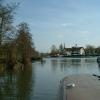
This is a lock with a rise of 3 feet and 1 inch.
| Bath Marina | 2 miles, 2½ furlongs | |
| Newbridge Road Bridge No 208 | 2 miles, 2 furlongs | |
| Kelston Park Railway Bridge (disused) | 1 mile, 2½ furlongs | |
| Saltford Marina | ¾ furlongs | |
| Kelston Lock Weir Entrance | ½ furlongs | |
| Kelston Lock No 5 | ||
| The Shallows Railway Bridge No 210 | 2½ furlongs | |
| Mead Lane Moorings | 4¼ furlongs | |
| Saltford Lock Weir Entrance | 6¼ furlongs | |
| Saltford Lock No 4 | 6¾ furlongs | |
| Wessex Water Services | 1 mile, 2¾ furlongs | |
Why not log in and add some (select "External websites" from the menu (sometimes this is under "Edit"))?
Mouseover for more information or show routes to facility
Nearest water point
In the direction of Hanham Lock No 1
In the direction of River Avon Junction
Nearest rubbish disposal
In the direction of Hanham Lock No 1
In the direction of River Avon Junction
Nearest chemical toilet disposal
In the direction of Hanham Lock No 1
In the direction of River Avon Junction
Nearest place to turn
In the direction of Hanham Lock No 1
In the direction of River Avon Junction
Nearest self-operated pump-out
In the direction of Hanham Lock No 1
In the direction of River Avon Junction
Nearest boatyard pump-out
In the direction of Hanham Lock No 1
Wikipedia has a page about Kelston Lock
Kelston Lock is a canal lock situated on the River Avon, between the villages of Kelston and Saltford, between Bristol and Bath, England.
The Bristol Avon Navigation, which runs the 15 miles (24 km) from the Kennet and Avon Canal at Hanham Lock to the Bristol Channel at Avonmouth, was constructed between 1724 and 1727, following legislation passed by Queen Anne, by a company of proprietors and the engineer John Hore of Newbury. The first cargo of 'Deal boards, Pig-Lead and Meal' arrived in Bath in December 1727. The navigation is now administered by the Canal & River Trust.
Above and below the lock and weir are permanent moorings. The Riverside Inn and Saltford Marina are also close by.
A branch of the river runs behind "Brass Mill Island", named for the annealing ovens of the former brass mill. The mill closed in the 1840s.


![River Avon below Kelston Lock [No 5]. Some pollution has blown up against the bottom lock gates. by Christine Johnstone – 03 May 2015](https://s3.geograph.org.uk/geophotos/04/48/38/4483883_f14a56de_120x120.jpg)


![River Avon at Kelston Weir. To the left is the Riverside Inn (see [[180928]]). On this side of [[180915]], the lock is scarcely visible. See also [[33971]] and [[974004]]. This view is from beside the Bristol & Bath Railway Path. by Derek Harper – 09 March 2010](https://s3.geograph.org.uk/geophotos/01/84/54/1845451_eb4f7071_120x120.jpg)







![Weir on the River Avon, alongside Kelston Lock. With a 'normal drop of 37 inches [just under a metre]. by Christine Johnstone – 03 May 2015](https://s2.geograph.org.uk/geophotos/04/48/38/4483886_b23a9489_120x120.jpg)

















